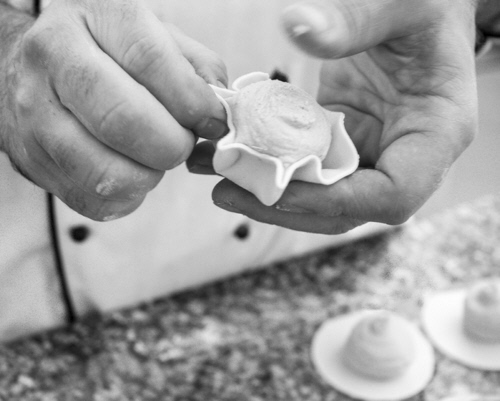We went to the confectionery of Mario at Piazza Sant’Antioco in Mogoro. Upon entering the shop, we were struck by the sight of so many tempting sweets and the intoxicating fragrance which permeated all the confectionery. After having presented ourselves, Mario showed us his workshop and after a brief explanation, started to prepare pastries called formaggellas and explaining how he made them at the same time.
A formagella is a typical Sardinian pastry made at Easter, but now it’s produced all year, whose recipe varies from region to region and the same applies to all other Sardinian sweets. In other words, every region of Sardinia has its own tradition leading to that it’s often possible to find various versions of the same type of sweets, but with different names. For example, formaggellas are also called pardulas and casadinas.
The stuffing of formaggellas may be based on grated, fresh cheese or as Mario was doing: using ricotta derived from sheep’s milk, salt (for bringing out the flavours), grated orange and lemon peel, saffron and yolk which causes the characteristic golden colour after cooking, flour and a little yeast, in order to soften the stuffing. After having mixed the ingredients, the stuffing needs to rest in order to avoid cracks appearing in the stuffing during cooking, and in order to let the ingredients become united at the same time creating a unique and unmistakable taste of formaggellas. Mixing plain white flour, lard, a little salt and lukewarm water, Mario had prepared the dough in advance laminating it in a dough roller and letting it rest on a workbench. Using a circular stencil, he made small circular “islands” in the dough, then he poured the stuffing onto each “island” using a piping bag. He folded the dough around the stuffing and pinched the dough such that it got the stellar shape of a formaggella. Finally, he put the formaggelas on a baking tray and cooked them at 180°C for 20 minutes. Always being patient and helpful, Mario also showed us how he made other types of sweets and a braided bread.
Having visited several confectioneries, I have noticed that confectioners are using machines like kneaders and dough rollers in order to avoid tiring and repetitive work. Instead, they are working their products manually in those cases where manual dexterity is required, e.g. making adornments.
During our visit, I realised that in order to become a good confectioner, requires years of experience and it’s not just “know how to make sweets”, but experiment and improvise, know the characteristics of the ingredients and how they interact in order to create sweets with a unique taste. Skills which Mario clearly have, seeing how he worked in his workshop and looking at his creations on his facebook page, it’s easy to recognise a master confectioner.

